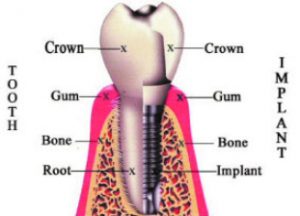 Many of our patients start their consultation for dental implants very confused from the numerous advertisements they have read. Often times, patients are not clear exactly what a dental implant consists of or how it can be used to help replace a missing tooth or teeth.
Many of our patients start their consultation for dental implants very confused from the numerous advertisements they have read. Often times, patients are not clear exactly what a dental implant consists of or how it can be used to help replace a missing tooth or teeth.
The Basics:
Teeth consist of 2 parts: the Crown- the part you see when you smile and chew with and the Root- the part in the bone and under the gums that gives support. When teeth need to be removed and replaced (this can be due to a number of factors such as decay or bone loss), one option is to use a dental implant. An implant is often referred to as a “root placement”. When the entire tooth is extracted, the crown and root are removed. This leaves an empty space or socket in the bone where the old root used to live. An implant or “new root” can ultimately be placed in the site of the socket and over time the bone in the area can “glue” itself to this implant. Typically, this gluing can take around 3-6 months. Once this occurs, a new crown can be cemented onto the implant to complete the process of replacing the tooth.
Traditionally, when a tooth is removed, a bone graft is placed in the extraction socket to aid in regrowing bone in the site. After a period of healing, an implant is placed into the area with the newly formed bone acting as a support structure for this new root. Three to Six months after the implant has been placed into the area, a crown can usually be attached to complete the process.
Immediate Dental Implants:
A more advanced technique that can be utilized involves placing the dental implant into the tooth extraction site at the time the tooth is removed. This can be very tricky as variations in bone anatomy, shape and hardness can impact the stability and position your surgeon can place the implant. On the positive side, research has shown that placing an implant at the time of tooth extraction may help preserve the jaw bone structure around the implant area. In addition, fewer procedures may be needed if the implant is able to be inserted in the same appointment.
Due to the additional complexity of this procedure, we find the use of a 3D x-ray (CT scan) of the mouth area to be critical to helping decide if the use of immediate implant placement is appropriate in each individual case. Having an in-depth knowledge of the anatomy, including location of the nerves and sinuses, can help identify the safest and least invasive approach.
No tooth replacement site is the same and success can vary patient to patient and site to site. In some situations, such as areas of significant infection, the traditional approach to implant placement may be a better option. The more information your surgeon has regarding the areas being considered for treatment can help increase success and assist with determining the best approach for your individualized needs.
www.PBCPERIO.com
561-691-0020
Check Also
Trusted Homecare Agency: Serving Veterans with Free Supplemental Home Healthcare
When it comes to healthcare, veterans deserve the best care possible. For veterans seeking in-home …
 South Florida Health and Wellness Magazine Health and Wellness Articles
South Florida Health and Wellness Magazine Health and Wellness Articles




